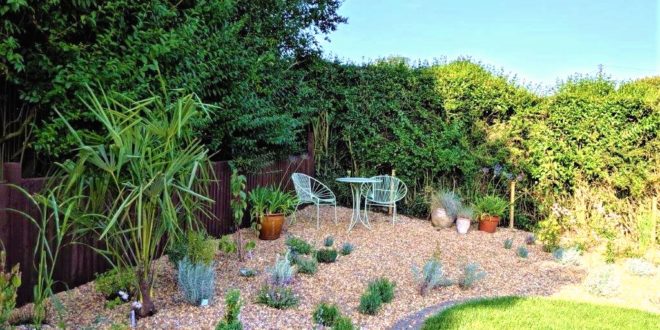Everyone loves a beautiful garden. A garden that looks, feels and smells just right. With comfortable seating areas and paths traversing a journey through the plants. A fantastic view to look out at from inside the house. Planting that lifts the spirits in the depths of winter as well as the heights of summer.
We’ve all been to such gardens, but why shouldn’t we aspire to such gardens ourselves? And if so, how to achieve it? Of course, you could go down the route of hiring a garden designer, and there are many good reasons for this. However, if you are the adventurous type who loves a challenge, doesn’t mind hard work and are willing to research the subject, designing your own garden can be hugely rewarding. Up and coming garden designer, Richard Walters (www.rwgardens.co.uk), describes how it is possible to create your very own garden design.
PLANNING AND RESEARCH
The first step towards your garden design is the survey ie an accurate map of your existing garden. Firstly measure the house and windows, very important when considering viewpoints. Then map the garden boundaries and existing hard landscaping ie patios and paths, finally adding on trees and borders. When you have surveyed your house and garden you should then transpose this onto a scale plan (1:100 is the easiest scale to work to, although 1:50 is great for smaller gardens). This is your base document, so make lots of copies for playing around with different design ideas.
Now is the fun bit where you can start drawing up your new garden. Before you do though, you should consider the style of garden that you’d like. For instance do you like the informal style of the English cottage garden or maybe you’d rather have a lower maintenance Mediterranean style garden, with gnarled Olive trees and silvery foliage plants? If you’d like a Japanese feel to the garden consider including cloud pruned conifers, classic red Acers and ferns and hostas in the shade.
HARD LANDSCAPING
Next comes setting up the basic structure of the garden. Seating and eating areas are often the best place to start. Give yourself a generous patio area, allowing more than enough room for table and chairs. West facing patios, to catch the afternoon and evening sun are ideal.
A path to the driveway is vital, make sure this is in a straight line if possible. Whilst a meandering path may be fun the first few times, the novelty will quickly wear off. Also think about adding vertical structure, for instance, pergolas to cover steps or paths or trellises to hide unsightly areas – these can be covered with climbers later on.
It’s also important to consider the practical aspects such as where best to locate the wheelie bins, or compost heaps. Do you need outdoor storage, if so where best to position the shed? Even small aspects such as washing lines should be considered at this stage.
ARCHITECTURAL FOCAL POINTS
At this point it is appropriate to consider additional ornaments or focal points around the garden. These may include formal or informal water features, topiary, iron or wooden carvings or even statues or statuettes. These should be positioned so that are seen from key areas and ideally located so as to draw the eye through the garden.
THE PLANTING SCHEME
Only after you have a really strong structural design should you start thinking about the planting plan. When considering plants, especially trees and shrubs, you should be mainly concerned about how they perform in the late autumn and winter. A garden that looks good in the winter will almost always look great in the summer. Besides which, you can add lots of summer flowering perennials to augment your trees and shrubs.
For the planting plan start by thinking trees – how many and how big. Even the smallest garden should include at least one tree. Trees add structure and maturity to a garden. They give great options for year round colour, including spring blossom, summer shade, autumn foliage colour and winter berries.
After that you can pencil in the herbaceous borders. Be bold, the deeper and larger you make them, the better – who needs lawns! For the back of the borders consider winter flowering, highly fragrant shrubs in amongst evergreens. Architectural grasses, such as Miscanthus and Calamagrostis, will also add movement and structure to the garden throughout the winter whilst the bare stems of dogwoods provide a great variety and range of colours.
Perennials should be planted between the shrubs to add summer colour and to provide immediate and ongoing interest whilst the shrubs are maturing. Bulbs can be planned to give year round interest, from snowdrops and bluebells to alliums and tulips through to nerines and winter aconites. Finally, don’t forget to include as many ground cover plants as needed, so much better than constant weeding!
About the author: Richard Walters (www.rwgardens.co.uk) is a Norfolk based garden designer specialising in small and medium garden design and landscaping.
 Gardeners Club The Gardeners Club is a free to join online club for everyone with an interest in gardening and gardens.
Gardeners Club The Gardeners Club is a free to join online club for everyone with an interest in gardening and gardens.






